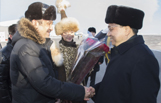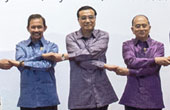Memories of blood and terror - Revisiting Nanjing
(Xinhua) Updated: 2014-12-13 07:21SLAUGHTER AND SALVAGE
Today Caoxiexia valley to the northwest of the city is a quiet place. A white monument stands by the road and what was once a reed field is now a water plant.
Zhao Jinhai, guard at the water plant, told Xinhua that people often brought flowers and wreaths for the dead.
Duan Yueping, 82, founder of the Memorial Hall of the Victims of the Nanjing Massacre by Japanese Invaders, spoke of a survivor named Tang Guangpu, who had witnessed the atrocities at Caoxiexia firsthand.
At about 4 a.m. on December 18, 1937, Japanese soldiers began tying up their prisoners, it took them more than 10 hours.
Then they led the bound prisoners to the Yangtze River and executed them with rapid gunfire.
"That day, the river ran red," Duan said.
Tang hid beneath a corpse until the executers left.
But he was lucky, as sometimes, the Japanese not only shot the prisoners, but also bayoneted and threw them on a burning pyre afterward.
A Japanese veteran soilder Riichi Kurihara (direct translation) said in his post-war account that they burned the corpses to destroy evidence of their barbarism.
"Not all the bodies were completely incinerated, leaving a black mountain of charred corpses," he said. "It was time-consuming to throw the corpses into the river and that lasted until noon the second day."
The campaign of murder, rape and looting shocked foreigners in the city, many of whom tried to protect the Chinese people, such as German businessman John Rabe.
His former residence, a two-story black building in downtown Nanjing, concealed and protected more than 600 people.
In the guest book, a visitor from the US, Carol Aschu, said: "We have read Iris Chang's book, 'The Rape of Nanking', and we are glad to find Rabe's house. This is an important story, both of atrocity and of aid, that no one should forget."X Another foreigner Wilhelmina Vautrin, then head of the Education Department of the Jinling Women's Arts and Science College, is remembered by a bust erected several hundred meters away from where the Chinese hid.
"We lived in classrooms, it was so crowded that when you wanted to turn over in the bed, you had to tell the person next to you," recalled Wu Zhengxi, 90.
However, these "safe zones" were not always so.
Wu's brother was taken from the college on the claim that he was a infidel.
"Several days later, I found him by a pool, tied to many others," said the old man, tears in his eyes. "He was a middle school student and I recognized his sports shoes. He was dead."
Wu's aunt, who also took refuge in the college, was snatched by the Japanese one day as she tried to sneak home.
"She committed suicide after being raped. I could not tell our family about this."
REMEMBRANCE
Aug. 15, 1945, the day the Japanese surrendered, will always be a day Wu remembers.
"I was helping in our restaurant, when I heard a man's voice from the radio. His voice sounded slow and somber," he said.
When he looked out into the alley, he saw the Japanese troops kneeling down. The Japanese had lost the war.
In the decades that have passed since these tragedies, the house where Chang's relatives died is now the site of an apartment building and Wu's restaurant is now a cell phone store.
But the names of their loved ones are etched, among with 10,000 more, on the 70-meter-long memorial wall in the Memorial Hall of the Victims of the Nanjing Massacre by Japanese Invaders.
More names are to be added, as experts generally agree that the number of victims to be nearer to 300,000.
Sun Zhaiwei, a research fellow with the Jiangsu provincial academy of social sciences, spent more than 30 years reviewing the records of charity organizations and the Kuomintang government. He confirmed that some 246,000 bodies were buried.
But tens of thousands of bodies were thrown into the Yangtze River, never to be found.
When asked about the denial of the massacre by right-wing nationalists in Japan, both Chang and Wu became emotional.
"They are liars," Chang said, before continuing with flurry of vitriol. While Wu asked: "Are they even human?"
There are only around 100 survivors of the massacre still alive.
To ensure lessons will be learned and the truth heard, both Chang and Wu are penning memoirs.
"I want to let more people know about what really happened 77 years ago, which every generation should remember," Chang said.
Wu's only wish is: "To live to hear the Japanese sincerely apologize."










